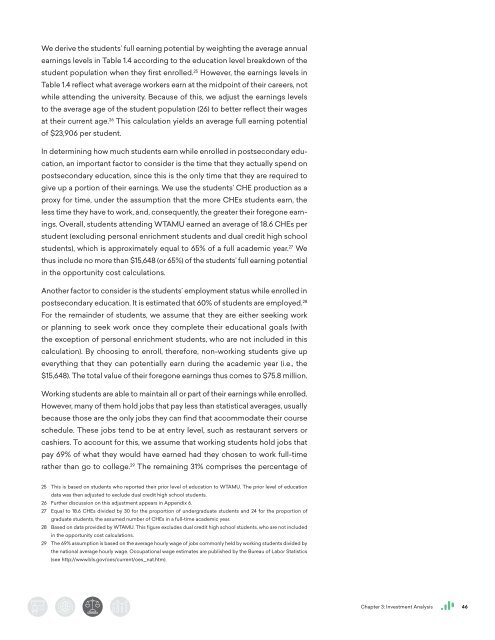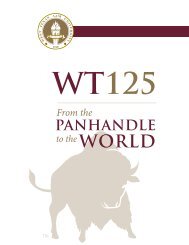The Economic Value of WTAMU Main Report
This report assesses the impact of West Texas A&M University (WTAMU) on the regional economy and the benefits generated by the university for students, taxpayers, and society. The results of this study show that WTAMU creates a positive net impact on the regional economy and generates a positive return on investment for students, taxpayers, and society.
This report assesses the impact of West Texas A&M University (WTAMU) on the regional economy and the benefits generated by the university for students, taxpayers, and society. The results of this study show that WTAMU creates a positive net impact on the regional economy and generates a positive return on investment for students, taxpayers, and society.
Create successful ePaper yourself
Turn your PDF publications into a flip-book with our unique Google optimized e-Paper software.
We derive the students’ full earning potential by weighting the average annual<br />
earnings levels in Table 1.4 according to the education level breakdown <strong>of</strong> the<br />
student population when they first enrolled. 25 However, the earnings levels in<br />
Table 1.4 reflect what average workers earn at the midpoint <strong>of</strong> their careers, not<br />
while attending the university. Because <strong>of</strong> this, we adjust the earnings levels<br />
to the average age <strong>of</strong> the student population (26) to better reflect their wages<br />
at their current age. 26 This calculation yields an average full earning potential<br />
<strong>of</strong> $23,906 per student.<br />
In determining how much students earn while enrolled in postsecondary education,<br />
an important factor to consider is the time that they actually spend on<br />
postsecondary education, since this is the only time that they are required to<br />
give up a portion <strong>of</strong> their earnings. We use the students’ CHE production as a<br />
proxy for time, under the assumption that the more CHEs students earn, the<br />
less time they have to work, and, consequently, the greater their foregone earnings.<br />
Overall, students attending <strong>WTAMU</strong> earned an average <strong>of</strong> 18.6 CHEs per<br />
student (excluding personal enrichment students and dual credit high school<br />
students), which is approximately equal to 65% <strong>of</strong> a full academic year. 27 We<br />
thus include no more than $15,648 (or 65%) <strong>of</strong> the students’ full earning potential<br />
in the opportunity cost calculations.<br />
Another factor to consider is the students’ employment status while enrolled in<br />
postsecondary education. It is estimated that 60% <strong>of</strong> students are employed. 28<br />
For the remainder <strong>of</strong> students, we assume that they are either seeking work<br />
or planning to seek work once they complete their educational goals (with<br />
the exception <strong>of</strong> personal enrichment students, who are not included in this<br />
calculation). By choosing to enroll, therefore, non-working students give up<br />
everything that they can potentially earn during the academic year (i.e., the<br />
$15,648). <strong>The</strong> total value <strong>of</strong> their foregone earnings thus comes to $75.8 million.<br />
Working students are able to maintain all or part <strong>of</strong> their earnings while enrolled.<br />
However, many <strong>of</strong> them hold jobs that pay less than statistical averages, usually<br />
because those are the only jobs they can find that accommodate their course<br />
schedule. <strong>The</strong>se jobs tend to be at entry level, such as restaurant servers or<br />
cashiers. To account for this, we assume that working students hold jobs that<br />
pay 69% <strong>of</strong> what they would have earned had they chosen to work full-time<br />
rather than go to college. 29 <strong>The</strong> remaining 31% comprises the percentage <strong>of</strong><br />
25 This is based on students who reported their prior level <strong>of</strong> education to <strong>WTAMU</strong>. <strong>The</strong> prior level <strong>of</strong> education<br />
data was then adjusted to exclude dual credit high school students.<br />
26 Further discussion on this adjustment appears in Appendix 6.<br />
27 Equal to 18.6 CHEs divided by 30 for the proportion <strong>of</strong> undergraduate students and 24 for the proportion <strong>of</strong><br />
graduate students, the assumed number <strong>of</strong> CHEs in a full-time academic year.<br />
28 Based on data provided by <strong>WTAMU</strong>. This figure excludes dual credit high school students, who are not included<br />
in the opportunity cost calculations.<br />
29 <strong>The</strong> 69% assumption is based on the average hourly wage <strong>of</strong> jobs commonly held by working students divided by<br />
the national average hourly wage. Occupational wage estimates are published by the Bureau <strong>of</strong> Labor Statistics<br />
(see http://www.bls.gov/oes/current/oes_nat.htm).<br />
Chapter 3: Investment Analysis 46





